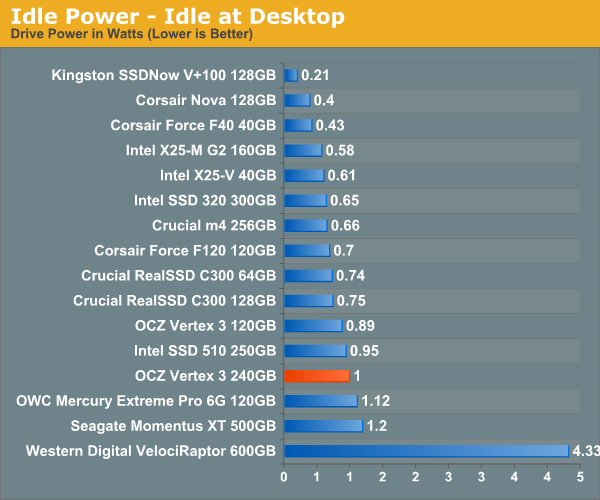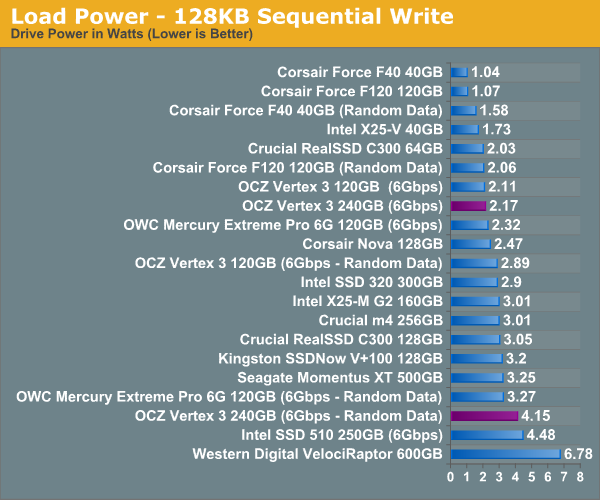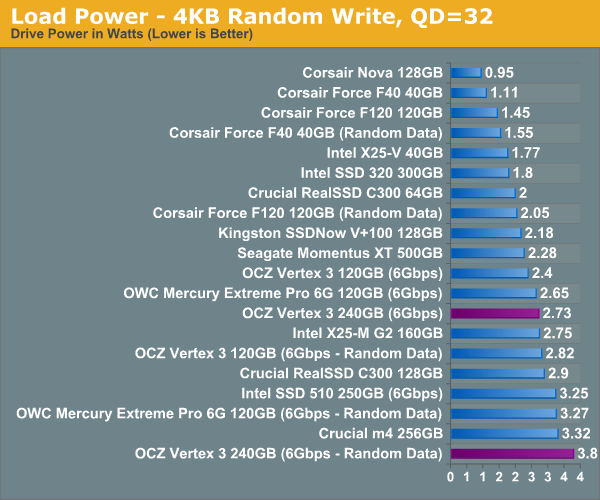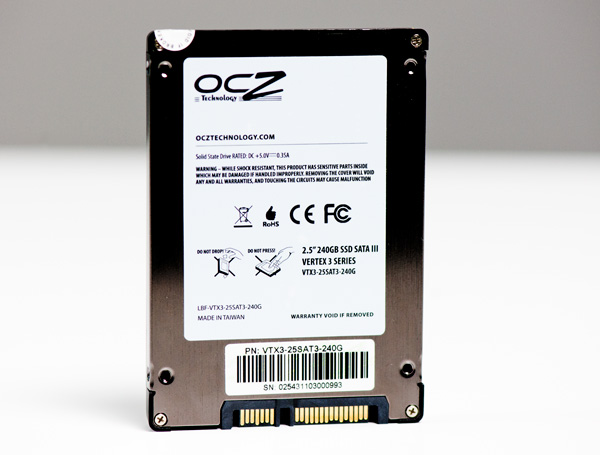OCZ Vertex 3 (240GB) Review
by Anand Lal Shimpi on May 6, 2011 1:50 AM ESTTRIM Performance
In practice, SandForce based drives running a desktop workload do very well and typically boast an average write amplification below 1 (more writes to the device than actual writes to NAND). My personal SF-1200 drive had a write amplification of around 0.6 after several months of use. However if subjected to a workload composed entirely of incompressible writes (e.g. tons of compressed images, videos and music) you can back the controller into a corner.
To simulate this I filled the drive with incompressible data, ran a 4KB (100% LBA space, QD32) random write test with incompressible data for 20 minutes, and then ran AS-SSD (another incompressible data test) to see how low performance could get:
| OCZ Vertex 3 240GB - Resiliency - AS SSD Sequential Write Speed - 6Gbps | |||||
| Clean | After Torture | After TRIM | |||
| OCZ Vertex 3 240GB | 284.4 MB/s | 278.5 MB/s | 286.3 MB/s | ||
| OCZ Vertex 3 120GB | 162.1 MB/s | 38.3 MB/s | 101.5 MB/s | ||
The 240GB drive is simply more resilient when faced with the same length of workload than the 120GB drive. It's possible that the extra physical spare area the 240GB drive has is responsible for its better behavior after torture. The larger drive may simply have to be tortured for longer in order to see a similar drop in performance. However 20 minutes of incompressible 4KB random writes would still fill up all of the drive's spare area and force the SSD into block recycling in only half that time. SandForce's block cleaning algorithm might do very well on the first pass of filling the drive but fall short after multiple passes where the spare area is overwritten. Either way, a desktop user is highly unlikely to ever encounter any serious slowdown with the 240GB drive.
Power Consumption
Power consumption is in line with the 120GB Vertex 3. Our earlier sample had issues with idle power consumption which have since been resolved in the final shipping firmware. Note that all of our tests are conducted with LPM disabled, a feature that seems to be problematic on some combinations of chipsets and SF-2200 hardware.



Final Words
When we previewed the 240GB Vertex 3 it looked like game over for the SandForce competitors this round. With the final hardware tested, I have to agree with our original conclusion. If you're spending $500 on a drive, the 240GB Vertex 3 is your best bet.
There are some mild changes in the results here and there but nothing significant (other than lower power consumption compared to the pre-release sample). Intel's SSD 510 and Crucial's m4 are the closest competitors. The only reason I can see going for Intel's 510 over the 240GB Vertex 3 is the reliability aspect. Intel has typically had lower return rates than OCZ and while OCZ tends to take care of its customers very well, many would just rather not have an issue to begin with. I will say that SandForce reliability has come a long way in the past year but there's still a lot of proving that both SF and OCZ have to do with the Vertex 3 to really cement themselves as a top tier player in the SSD space.











90 Comments
View All Comments
Just3r1d7 - Saturday, May 7, 2011 - link
Dear Anand,I have been carefully reading SSD articles for the past 18 months waiting for the right time to make a purchase for both my home and work PCs... The depth and breadth of SSD coverage on AnandTech has been stellar, and this latest Vertex 3 review is no exception.
It's clear that the Vertex 3 240GB is the "best performing" drive for $500. However, as other posters have noted, all of the information floating around about SSDs hasn't necessarily resulted in clear guidelines or practical recommendations.
My guess is that the "average" user isn't going to spend $500 on an SSD for their home PC... Thus, as you continue to conduct these reviews, it may be helpful to compile a table/chart to guide your dedicated readers (and anyone else who browses the site). This would also have the benefit of reducing the number of "I have Processor A, Chipset B, and Operating System C, which SSD should I buy?" questions that arise.
Here are a few examples of questions which seem to come up repeatedly and could probably be answered by a summary table of recommendations based on drives currently available in retail channels:
1. What is the best "small" capacity drive? (at any cost)
2. What is the best "low cost" drive? (at any capacity)
3. What is the best performing OS/application drive?
4. What is the best drive for non-TRIM supported OS? (e.g. WinXP or Mac)
5. What is the best (most reliable) drive for a business PC?
Just some food for thought... Keep up the great work on the SSD coverage and reviews!
-Bob
Wardrop - Saturday, May 7, 2011 - link
Anyone know when OCZ will refresh their RevoDrive line with SF2xxx controllers? I'll be getting one of them.iwod - Sunday, May 8, 2011 - link
In an ideal world, the NAND would get smaller every node shrink, and we could fit more die inside an NAND package.However with every die shrink they also double the capacity of the minimum die size. i.e from 64Gbit to 128 Gbit ... etc
If 8 Channel and 8 NAND Package being a constant factor, we are only going to get more capacity at the same price, but not lower price at lower capacity.
Is there any reason behind this?
And that is why when i see people saying i will wait for SSD to drop below $50 etc.... They are halving the price every year so i will wait a year or two before i get it. The truth is it is never going to happen. The absolute minimum BOM *equation* for SSD has stay constant for years. Unless the minimum price per NAND die is going to drop, may be what we see today is already the absolute minimum price / SSD we will ever see?
ibliblibli - Sunday, May 8, 2011 - link
A thorough review, but I'd like to understand why the HDTach charts showing the read-and-write performance before-torture, after-torture and post-TRIM are not shown. I know the average sustained writes do not change much even after torturing the drive, but I'm interested in the volatility. None of other the articles covering the latest Sand Force drives (OCZ Vertex 3 Pro/Non-Pro 240 GB Previews, OCZ Vertex 3 120 GB Review, OWC Mercury Extreme Pro 6G Review) show this data either. However, the reviews for the other new drives (Intel 510, Intel 320 and Crucial m4) includes those charts. Is there a reason for this exclusion? The information from those charts is helpful.NorthShoreExile - Monday, May 9, 2011 - link
Based on the initial review, I ordered one for my new build. It took weeks to arrive but I finally got it. All I can say is "WOW"! It is everything it claims to be.jinino - Monday, May 9, 2011 - link
Great review Anand,From the photo in the last page, I see the disk is made in Taiwan. Do you happen to know that OCZ's SSD is manufactured by the same OEM in Taiwan as the manufacturer for Intel's SSD?
alpha754293 - Monday, May 9, 2011 - link
Wonderful review on the OCZ Vertex 3 SSD.I was wondering if you might be able to run the full h2benchw benchmark on the drive?
You should be able to download it here:
http://www.heise.de/software/download/h2benchw/378... or just google it.
Can you post or email me the results please?
Thank you.
ueharaf - Tuesday, May 10, 2011 - link
what is the difference between vertex 3 and solid 3?http://www.ocztechnology.com/ocz-solid-3-sata-iii-...
sanguy - Tuesday, May 10, 2011 - link
Hi,We just received 5 Vertex 3 240GB drives for installation into some Dell E6520 laptops. We did the install but with the Vertex 3 installed we've been having random system lock-ups that require a hard boot.
We are in AHCI mode in the bios and running Windows 7x64 with the 10.1 Intel RST drivers. Drives are firmware 2.02.
We are seeing this on several laptops/drives so it's not a one off.
Drive is detected by the toolkit OCZ has available, and RST reports it correct at 6Gbps.
These are sandy bridge quad core laptops using a 6 series chipset.
Anyone seeing compatibility issues? I did find a thread at OCZ over disabling some function in the registry which we did without it solving the issue.
DanaG - Wednesday, May 11, 2011 - link
I'd say Sandforce drives are just plain buggy, if you try to do anything non-desktop with them. (Even my old Indilinx drive was more stable.)From what you're seeing, the new ones must be even worse than the old ones.
Check my comments on Page 6, and this link:
http://www.ocztechnologyforum.com/forum/showthread...